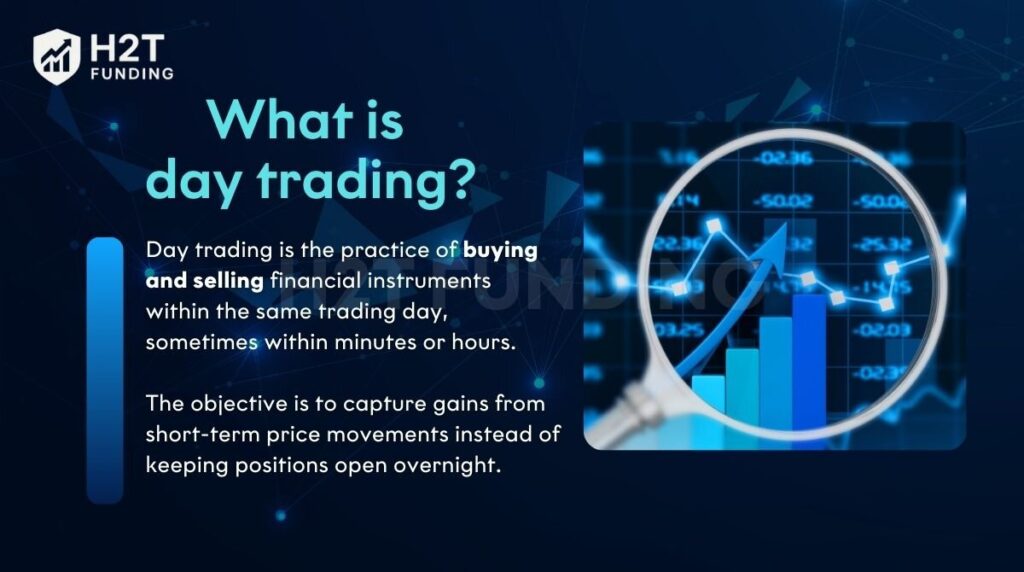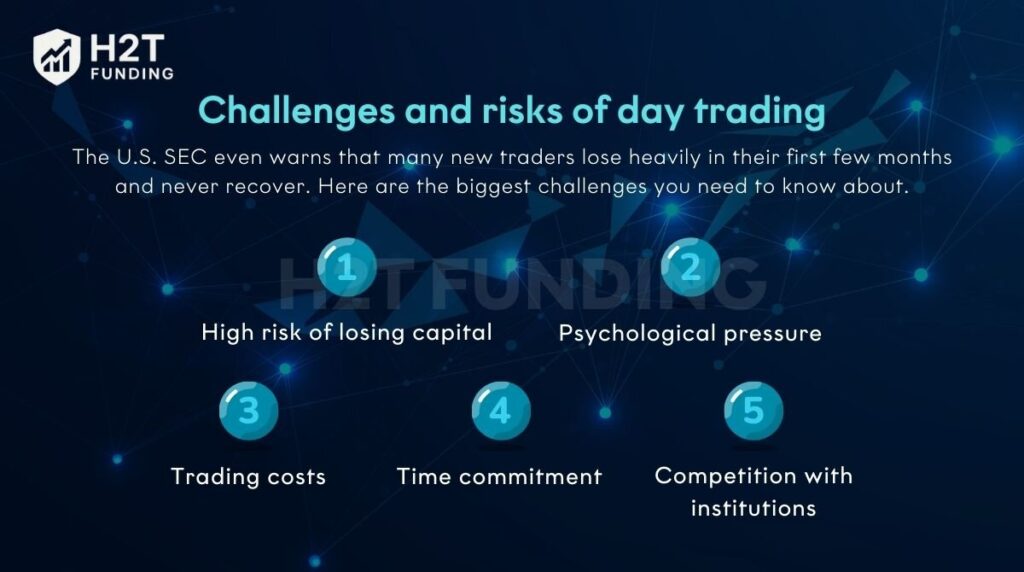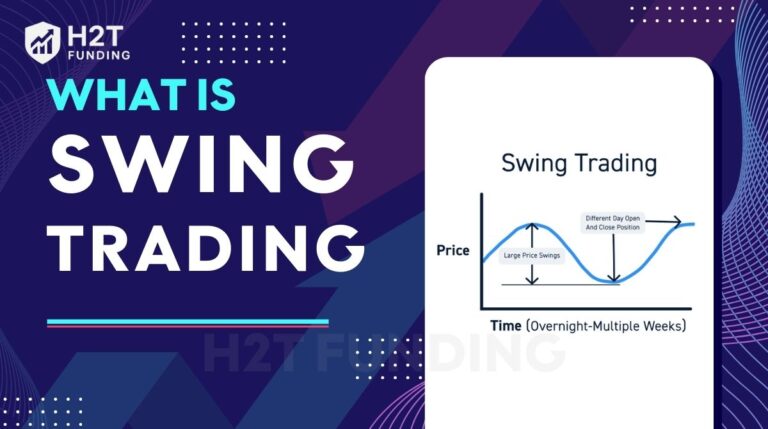From YouTube success stories to flashy TikTok clips, day trading is often painted as a golden ticket to freedom and instant wealth. You see creators bragging about quitting their jobs, trading from a laptop by the beach, and living off stocks, forex, or crypto. It all looks tempting, almost too good to resist.
But here’s the reality: can you make a living as a day trader? Yes, but it’s far from easy. According to a study in Investopedia, only about 3% of day traders are consistently profitable, and fewer than 1% achieve long-term success.
These numbers suggest day trading is more difficult than the hype makes it seem. In this article, H2T Funding offers a realistic look at what “making a living” truly means and the truths you face before going into day trading full-time.
Key Takeaways
- Day trading involves buying and selling securities within the same day to capitalize on short-term price fluctuations.
- Many people are drawn to day trading for the promise of freedom, independence, and uncapped income.
- In reality, average sustainable returns are around 2–5% per month. With $10,000 in capital, that’s only $300–$500 monthly, far from a full-time income ($3,000–$6,000/month) unless you trade with much larger funds.
- The challenges of day trading include that most traders lose money, the psychological pressure is intense, costs eat into profits, and competing against institutions makes the game even more difficult.
- A realistic way to make a living as a day trader is to have strong capital, a proven strategy, strict risk control, and treat it as a profession.
1. What is a day trading?
Day trading is the practice of buying and selling financial instruments within the same trading day, sometimes within minutes or hours. The objective is to capture gains from short-term price movements instead of keeping positions open overnight.

Day traders rely on quick decision-making, technical analysis, and risk management to capture small but frequent gains. In contrast to long-term investors, day traders exit all positions by the market’s close to eliminate overnight risks.
The most common markets for day trading include:
- Stocks: trading shares of companies like Apple, Tesla, or Microsoft.
- Forex (foreign exchange): connects traders worldwide to buy and sell currency pairs like EUR/USD or USD/JPY.
- Cryptocurrencies: volatile assets like Bitcoin and Ethereum.
- Futures and Options: contracts tied to commodities, indices, or interest rates.
In essence, day trading is fast-paced and high-risk. It can be rewarding for skilled traders, but it also requires discipline, tools, and experience to avoid costly mistakes.
2. Why do people want to day trade for a living?
The appeal is pure freedom: you’re your own boss, work from anywhere, and a salary doesn’t cap your income. Social media sells this dream hard, with endless clips of luxury lifestyles supposedly funded by trading. What’s missing is the brutal reality behind those highlight reels.
The main reasons people are drawn to day trading include:
- No boss, no office politics, you answer only to yourself.
- Flexible lifestyle, the ability to work from home, a café, or even while traveling.
- Potential for unlimited income in theory, profits depend on skill, not a fixed salary.
- Appeal of independence, escaping the 9-to-5 grind and building wealth on personal terms.
However, the dream is often very different from reality. Social media tends to showcase reels of success, screenshots of big wins, and freedom narratives. What’s rarely shown are the long hours of studying charts, the mental stress of losing trades, or the fact that most day traders do not achieve consistent profitability.
According to research in Investopedia in 2026, the success rate in day trading is quite low, with only around 3% to 20% of traders actually making money. For the rest, the small profits they might achieve rarely justify the significant time, stress, and risk involved.
In other words, people pursue day trading for freedom and control, but only a disciplined few manage to turn that dream into a lasting reality.
See more:
3. Can you make a living as a day trader?
So, the big question: can you make a living day trading? The short answer is yes, but only a small percentage manage to do it consistently. Success depends on capital, skill, discipline, and risk management. Most beginners underestimate the psychological pressure and the financial cushion required to sustain trading as a career.

3.1. What does make a living mean in this context?
When we ask if you can “make a living” through day trading, we’re not talking about occasional wins or lucky streaks. Instead, it means:
- Generate a consistent monthly income that covers rent, food, insurance, and bills.
- Having extra savings for retirement, emergencies, and reinvestment.
- Being able to handle losing months without blowing up your account or lifestyle.
In practice, a full-time day trader needs trading profits to match, or exceed, the equivalent of a stable salary. For someone in the U.S., this often means aiming for $3,000–$6,000 per month just to cover living expenses, depending on location.
Many traders confuse making money trading with making a living from trading. For example, a $500 weekly gain feels good, but after rent, insurance, and taxes, it can’t replace a job.
3.2. What income level is realistically achievable?
This is the reality check most people don’t want to hear. Broker reports and academic studies consistently show that over 70% of retail traders lose money. The handful who stay profitable long-term, maybe 10-15%, are the exception, not the rule.
To understand what’s “realistic,” let’s look at the math:
| Starting Capital | Target Monthly Return (realistic) | Monthly Profit | Annualized Profit |
|---|---|---|---|
| $10,000 | 3–5% | $300–$500 | $3,600–$6,000 |
| $50,000 | 3–5% | $1,500–$2,500 | $18,000–$30,000 |
| $100,000 | 3–5% | $3,000–$5,000 | $36,000–$60,000 |
The table makes it painfully clear: your starting capital dictates your potential income. A solid strategy on a $10k account is just a side hustle. That same strategy on a $100k account can actually start to replace a salary.
Traders often overestimate potential returns. They dream of doubling their accounts every month, but the reality is, sustainable trading looks more like 2–5% per month. That may sound small, but compounded over the years, it’s already better than most traditional investments.
Day trading is a profession, not a lottery; it requires capital, strategy, and discipline.
4. Factors that determine your success as a full-time day trader
When I first looked into day trading seriously, I realized it wasn’t just about staring at charts all day. What separates those who survive, and even thrive, from those who burn out comes down to a few critical factors. If you’re thinking about going full-time, here’s what you need to know.

4.1. Starting capital
Capital adequacy is critical. U.S. pattern day trader rules require at least $25,000 in a margin account, but realistically, you need a buffer above that. Having sufficient capital allows you to size positions correctly, withstand early losses, and avoid being forced out of trades too soon.
4.2. Trading strategy
Profitable day traders don’t rely on luck; they follow a tested strategy and a clear trading plan that defines entries, exits, risk per trade, and daily loss limits. A good trading strategy covers:
- When to enter and exit a trade.
- How big your trades should be is based on account size and risk.
- How much are you willing to lose per trade and per day?
- Which time frames (1-minute, 5-minute, 15-minute) do you use?
- Which trading indicators support your decisions?
- What markets you’ll trade: stocks, futures, forex, or crypto.
New traders can first test strategies using demo accounts or “paper trades.” This step helps refine setups and prevents costly early mistakes before risking real capital.
Don’t miss out: CFD trades with less than USD 25k account? A practical guide
4.3. Risk management and position sizing
Managing downside risk is non-negotiable. This means using stop-loss orders, setting daily loss limits, and keeping risk per trade to a small percentage of capital (often 1–2%). Proper position sizing prevents a single bad trade from wiping out weeks of progress.
Discover more helpful articles:
4.4. Consistency and trading edge
A trading edge, whether it’s speed, analysis, or pattern recognition, must be applied consistently. Sporadic wins mean little if your average losses are larger.
Consistency in execution and discipline is what separates sustainable traders from gamblers. Tools like support and resistance can provide reliable reference points to apply your edge consistently.
4.5. Psychological discipline and mental resilience
Trading is as much a mental game as a technical one. Emotional biases like FOMO, loss aversion, and overconfidence can derail even good strategies. Successful traders develop emotional control and bounce back quickly after losses without revenge-trading.
4.6. Market conditions and volatility
Day trading is more viable when markets are liquid and volatile. Knowing the rhythm of the 4 trading sessions helps traders identify when liquidity and volatility are highest, improving trade timing.
Assets with high liquidity and strong trading volume, like major forex pairs or popular stocks, usually provide better opportunities. In calm markets, day trading profits often shrink.
4.7. Costs: Commissions, spreads, taxes, software
Expenses eat into profits. Every commission, spread, or platform fee matters, especially for high-frequency traders. Taxes on short-term gains are higher, so profitability must account for after-tax returns, not just gross profits.
Continue reading: How much does a funded account cost? A complete price guide
4.8. Support system: Community, mentor, or prop firm
Day trading can be isolating. Having access to a mentor, a trading community, or even joining a prop trading firm provides accountability and shared learning. These support systems help shorten the learning curve and reduce costly mistakes.
As I mentioned, only about 3%–20% of day traders make money (Investopedia, 2025). This low success rate highlights how only those with enough capital, clear strategies, and discipline actually succeed. Without these, day trading more often drains accounts than provides a steady income.
5. Challenges and risks of day trading
For the average person, day trading is far more stressful and risky than it looks online. The U.S. SEC even warns that many new traders lose heavily in their first few months and never recover. Here are the biggest challenges you need to know about.

5.1. High risk of losing capital
Let’s be blunt: most new traders burn through their capital fast. The market’s short-term whims are brutal, and leverage acts like fuel on a fire. It’s not just about losing your savings; some people end up in debt to their brokers.
5.2. Psychological pressure
Day trading feels like a constant test of nerves. Staring at screens for hours, tracking dozens of price changes, and making split-second calls is exhausting. Emotions like fear, greed, or overconfidence often creep in and cause poor decisions.
5.3. Trading costs
Every trade comes with hidden costs. Commissions, spreads, and data fees eat into profits, while short-term taxes take another cut. Many traders are shocked to realize that their “winning” system turns unprofitable once all these costs are included.
5.4. Time commitment
Unlike long-term investing, day trading requires nonstop focus during market hours. You can’t simply walk away and let trades run. Many traders find it more draining than a traditional job, often leaving them mentally exhausted at the end of the day.
5.5. Competition with institutions
Retail traders are up against hedge funds and high-frequency trading firms with advanced tools and virtually unlimited resources. Competing on speed and technology puts the average trader at a serious disadvantage.
I vividly remember my own humbling start in forex with a $5,000 account. A quick $300 win on a EUR/USD breakout had me feeling invincible for a moment.
Then, a volatile news release a few days later cost me nearly $700 in minutes, wiping out weeks of progress. That loss taught me the hard way that I wasn’t just fighting the market, but my own foolish overconfidence.
Continue reading: How to understand trading charts: A new trader’s guide
6. Full-time vs part-time trading – Which is smarter?
Choosing between full-time and part-time trading is one of the biggest decisions aspiring traders face. Each path has unique advantages and risks, and the “smarter” option often depends on your personal situation.
| Aspect | Full-time trading | Part-time trading |
|---|---|---|
| Time commitment | Full focus during market hours, often 6–8 hours a day. | Flexible, can be done before/after work or during free time. |
| Income pressure | High, trading must cover all living expenses. | Low, main job provides financial stability. |
| Learning speed | Faster learning curve due to more screen time and trade volume. | Slower progress, but safer as mistakes won’t directly impact livelihood. |
| Stress level | Very high pressure to perform can lead to burnout. | Lower, less stress since income doesn’t depend solely on trading. |
| Opportunities | Access to more trades and setups throughout the day. | Limited – may miss trades during working hours. |
| Financial cushion | Requires significant savings to handle losing months. | Easier to manage since bills are paid by a stable salary. |
| Best for | Traders with strong capital, proven consistency, and a willingness to handle risk. | Beginners, learners, and those testing strategies without financial pressure. |
Full-time trading can be rewarding if you already have consistent results, solid capital, and the ability to handle both risk and stress. Part-time trading, on the other hand, fits those who are still learning, want to keep financial stability, and prefer to build skills gradually.
7. Realistic paths to making a living as a trader
While most beginners dream of quick wins, the reality is that building a sustainable trading career takes time and structure. Exploring options like getting into prop trading is one of several practical paths traders can take if their goal is to make a living.

7.1. Trading with significant personal capital
The most straightforward way is to trade your own money. With enough capital, think $50,000 to $100,000 or more, even modest monthly returns of 3–5% can add up to a livable income. The challenge here is that not everyone has that kind of capital, and even with it, strict risk management is essential.
7.2. Trading with a prop firm
Proprietary trading firms like FTMO or Topstep allow traders to access large funded accounts in exchange for passing evaluations and following risk rules. This model gives skilled traders a chance to earn from $50,000 to $200,000 accounts without risking personal savings, but the pressure of strict rules can be intense.
But remember, not all prop firms are trustworthy. Some promise big funding and quick payouts, but never pay or hide rules designed to make traders fail. Always check prop firm reviews and trader communities before signing up to be sure the firm is legitimate.
7.3. Combining trading with freelance or side income
Not every trader relies on markets alone. Many balance trading with freelance work, such as consulting, programming, or content creation. This approach reduces financial pressure and allows trading profits to grow steadily without being the sole source of income.
7.4. Treating trading as a profession, not a gamble
The most realistic path is to approach trading like a long-term career. That means investing in proper education, studying market mechanics, practicing with demo accounts, and learning from mistakes. Success doesn’t come from chasing “lucky” trades but from building professional-level skills over the years.
Each of these paths can work, but none is quick or effortless. The common thread is discipline, patience, and a willingness to treat trading as a serious craft. If you wonder if you can make a living by day trading, the honest answer is yes, but only with the right capital, strategy, and mindset.
8. Case studies & practical examples
Day trading can lead to very different outcomes depending on how traders approach risk, capital, and expectations. Some achieve steady growth and build a sustainable career, while others blow up their accounts within weeks. Let’s look at two contrasting examples to see what lessons can be learned.
8.1. Successful trader: Consistency after 3 Years
Take Jack, who spent three years refining skills in technical analysis, money management, and psychology, and was able to achieve stable profits. Instead of chasing huge returns, this trader targeted 4–7% per month, a range considered realistic by reputable prop firms like FTMO.
For example, with $100,000 capital, a 7% gain produces $7,000 profit. After a 70% profit split, the trader keeps $4,900, which is enough to cover living expenses and even savings. This success was built on patience, compounding, and strict risk control, not lucky trades.
8.2. Failed trader: Blowing account with excessive margin
On the other side, Jenna started with $1,000 but expected to grow it to $10,000 in a few months. To reach this unrealistic goal, they used extreme leverage, risking far more than 2% per trade.
A few losing trades were enough to wipe out the account completely. This scenario is common: small account size, high expectations, emotional stress, and eventually, overtrading. Instead of progressing, the trader fell into the cycle of depositing, losing, and quitting.
These two examples highlight a simple truth: the path to success is built on discipline and realistic goals, while failure often comes from impatience and over-leverage. To put the contrast into perspective, here’s how their approaches stack up:
| Factor | Successful trader | Failed trader |
|---|---|---|
| Starting Capital | $100,000 (prop firm funded) | $1,000 (personal savings) |
| Profit Target | 4–7% per month | 50–100% per month |
| Risk per Trade | 1–2% | 10% or more |
| Monthly Net Income | ~$4,900 (after profit split) | $0 (account blown) |
| Mindset | Patient, consistent, disciplined | Impulsive, stressed, unrealistic |
| Outcome | Sustainable career in trading | Account lost, no progress |
When you look at the comparison, the message becomes clear: success in day trading isn’t about chasing fast money, it’s about managing risk, keeping expectations realistic, and allowing time to do its work.
9. Discussion from the community
One of the best ways to understand day trading is through the voices of real traders. Their stories reveal both the harsh reality of failure and the slim but real possibility of success.

In the first story, a trader shared how they started with optimism, made small profits, but over time, losses piled up like a slow poison. Eventually, their savings were drained, forcing them to stop. Yet, they saw value in the experience, realizing what doesn’t work and how hard trading truly is.
Community replies also bring another perspective: success is possible, but only for a tiny minority. One trader noted that after six years, with a $100,000 account, they earn a few thousand dollars monthly while still keeping a regular job.

Others argued that the “99% fail” statistic is misleading. Still, the success rate remains extremely low, and discipline often makes the difference between survival and failure. These discussions show that while the path is tough, consistent effort and realistic goals can make long-term survival possible.
10. FAQs about living off day trading
Day trading can be rewarding, but it is not a stable or guaranteed career for most. Only a small percentage of traders generate consistent profits, and it requires discipline, capital, and resilience. Many traders prefer to see it as a business rather than a traditional career path.
On average, traders need 2–3 years of consistent practice to become sustainably profitable. This involves building a tested strategy, controlling emotions, and applying proper risk management. Some may see early success, but long-term profitability usually takes time.
Trading full-time with personal funds generally requires at least $25,000–50,000, as smaller accounts cannot generate enough income without taking excessive risks. Many traders choose prop firms to access larger capital instead of risking their own limited savings.
Earnings vary widely, but most profitable prop traders earn between $2,000 and $10,000 per month, depending on account size, split structure, and performance. With a $100,000 funded account, a 7% monthly gain can result in about $4,900 net income after a 70/30 split.
Quitting a job for trading is risky unless you already have at least 12–24 months of consistent profits and enough savings to cover living costs. Many successful traders keep a part-time or full-time job until their trading income is reliable.
Yes, but only a small minority manages to live entirely off trading. Most who succeed have either significant starting capital or trade with a prop firm. Even then, income can fluctuate month to month, so it requires careful financial planning.
It is possible, but the odds are low. Studies and broker data show that 70–90% of retail traders lose money. Those who do succeed usually focus on risk management, moderate profit targets (4–7% monthly), and avoid over-leverage.
A realistic expectation is 2–7% monthly returns. For example, with $50,000 capital, this translates into $1,000–3,500 before costs or splits. Anything beyond this is rare and usually unsustainable in the long run.
11. Conclusion
Not everyone is suited to live off day trading. The market is demanding, and while some succeed, most traders fail due to a lack of discipline, insufficient capital, or unrealistic expectations. The real question, can you make a living from day trading, depends entirely on how seriously you approach it.
The best way forward is to build strong skills, test your strategy until it shows consistent profits, and prepare mentally for losses. Day trading is not a shortcut to wealth but a business that requires patience, discipline, and risk management.
Before risking significant capital, consider practicing on a demo account or testing yourself with a prop firm. This gives you the chance to manage larger funds under real conditions without jeopardizing your savings.
In the end, can you make a living as a day trader? Yes, but only if you are disciplined, realistic, and willing to treat trading as a long-term profession. For deeper insights, explore the Prop Firm & Trading Strategies section on H2T Funding and prepare for a more sustainable journey.





